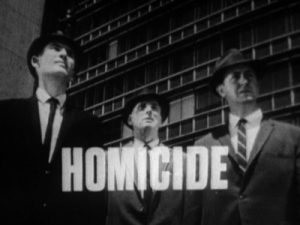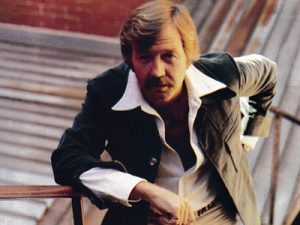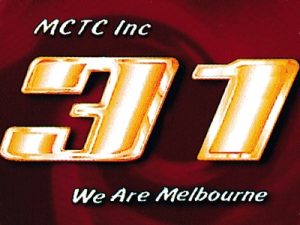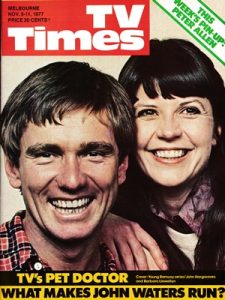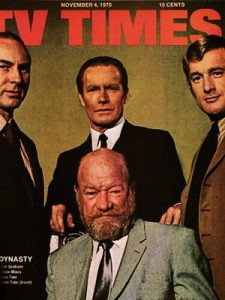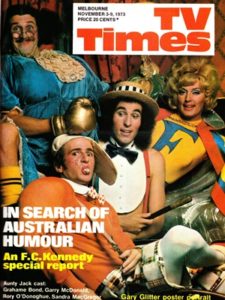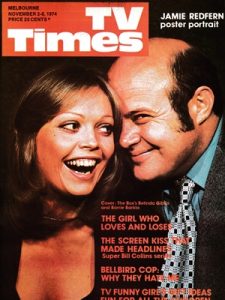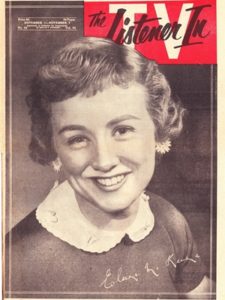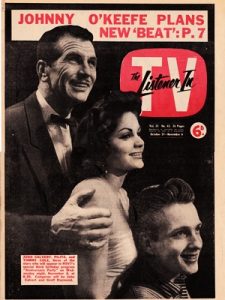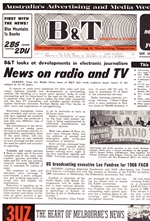 Although television in Australia was a decade old, in 1966 it was still newspapers and radio that were viewed by many as their primary sources of news — but the tide was turning as journalism was facing the sort of generational change not unlike current day trends towards online and multimedia reporting.
Although television in Australia was a decade old, in 1966 it was still newspapers and radio that were viewed by many as their primary sources of news — but the tide was turning as journalism was facing the sort of generational change not unlike current day trends towards online and multimedia reporting.
Media and advertising journal B&T presented a special issue in July 1966 devoted to the rise in ‘electronic journalism’ — marking the shift in technology from notebooks and typewriters to film cameras and tape recorders and the onset of a new generation of journalist, as Greg Ell, director of news at Sydney’s ATN7 noted:
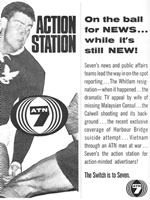 “The new breed hasn’t yet taken over control of television news in Australia, but the day is fast approaching. And, of course, I’m talking about television journalists — the pure-bred television men without a drop of printer’s ink in their veins.”
“The new breed hasn’t yet taken over control of television news in Australia, but the day is fast approaching. And, of course, I’m talking about television journalists — the pure-bred television men without a drop of printer’s ink in their veins.”
“Instead of understanding what a linotype machine can do he must know how a videotape machine can be used as a medium of illustration.”
“Fairly soon now, we’ll have more new tools… colour and eventually direct reports from overseas.”
While radio executives were talking up radio’s ability to provide immediacy in news reporting, television was making steady inroads into this aspect of news reporting — as told by GTV9 news editor Peter Maund:
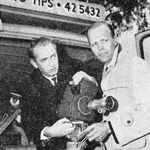 “In the past few weeks, GTV has interrupted programs with direct telecasts of events ranging from a million dollar fire at Fitzroy, through a Prince Charles departure at the airport, to Mr Calwell arriving back in Melbourne to make his first statement on the attempt on his life, to a hearing of the Football League Tribunal.”
“In the past few weeks, GTV has interrupted programs with direct telecasts of events ranging from a million dollar fire at Fitzroy, through a Prince Charles departure at the airport, to Mr Calwell arriving back in Melbourne to make his first statement on the attempt on his life, to a hearing of the Football League Tribunal.”
“Station has a compact, one-camera OB unit on permanent standby. It can be crewed and on the way ten minutes after the report of the event first hits the station.”
“Another heavy outlay in the cause of news immediacy was GTV’s investment in the coaxial cable link through Canberra to Sydney. GTV, supported by TCN9 in Sydney, put the first full-time representative into Canberra to give more breadth to the speedy three-city news exchange via the cable. We believe all this effort and expense pays dividends. It makes good news services, and this attracts viewers who want to be involved.”
Mike Williams, news editor for BTQ7 in Brisbane, said the challenge in adapting journalism to the television medium is for journalists to make the change from verbose newspaper reporting to shorter, sharper phrasing to accompany the vision:
“In most cases, the best television newsmen have come from radio — they managed the transition to the scurry of TV more readily than those steeped in newspaper tradition. Few newspaper men seem to be able to grasp the problems of an ever-ticking clock; the time it takes to film a story and have the film processed and edited. A good television newsman must have far more knowledge of his industry than his newspaper colleagues. He must have a sound basic knowledge of cine filming and editing techniques; and a broad knowledge of the technical equipment his station possesses.”
When television started it took three days to get news footage from overseas but by 1966 this delay was reduced to within 24 hours. TCN9 news director Michael Ramsden said television still has some work to do to match radio’s immediacy but technology is catching up:
 “Our aim is to get the news to the public as quickly as radio does. In my opinion, we are doing it better than radio, but we are sometimes not as fast. (The) news world is shrinking and will diminish further with the introduction in the Pacific area of a communications satellite. By then TV would be competing with radio in every phase.”
“Our aim is to get the news to the public as quickly as radio does. In my opinion, we are doing it better than radio, but we are sometimes not as fast. (The) news world is shrinking and will diminish further with the introduction in the Pacific area of a communications satellite. By then TV would be competing with radio in every phase.”
The Vietnam war, the first ‘televised’ war, also brought a new dimension to television news reporting, as Ian McFarling, news director at ATV0, Melbourne, recalls:
 “Nothing has perhaps dramatised the job of a television newsman than the coverage of the Vietnam war. Millions of Australians by now have seen them in action — hunched in front-line foxholes, even sprawled in ditches telling to their cameraman to duck the bullets. It’s an unenviable job. Sitting at home it looks exciting — even easy, granted a fair share of coverage. Yet despite the risks that these men take, I know that plenty of Australian television journalists would love to trade places, even for a while, because to any good newsmen there is no substitute for excitement and stimulation. But it is a mistake to think that any TV journalist is going to be in the glamorous frontline all the time, or, as far as most are concerned, even for part of it. This falls only to a limited number.”
“Nothing has perhaps dramatised the job of a television newsman than the coverage of the Vietnam war. Millions of Australians by now have seen them in action — hunched in front-line foxholes, even sprawled in ditches telling to their cameraman to duck the bullets. It’s an unenviable job. Sitting at home it looks exciting — even easy, granted a fair share of coverage. Yet despite the risks that these men take, I know that plenty of Australian television journalists would love to trade places, even for a while, because to any good newsmen there is no substitute for excitement and stimulation. But it is a mistake to think that any TV journalist is going to be in the glamorous frontline all the time, or, as far as most are concerned, even for part of it. This falls only to a limited number.”
While capital city TV newsrooms were able to indulge in spending up to boost their resources — TCN9’s Ramsden recalled that News was that channel’s highest budgeted program — spare a thought for some of the more remote TV news operations where minimal resources have to be stretched. Frederick T Yates, general manager of WBQ8 in Maryborough/Wide Bay, Queensland, said that some tough calls have to be made — and no matter how famous or important you are you could be upstaged by an unlikely rival! — such as this situation where there were two big local news stories but only one available cameraman:
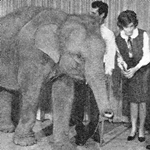 “Prince Charles was spending a relaxing few days on the big Santa Gertrudis stud at Eidsvold, 130 miles from the studio at Maryborough. There was a possibility that cameramen could get informal shots of the prince for half an hour one day. That very day the circus was in Eidsvold and their baby elephant Minyak decided to go walkabout. Major story was that they couldn’t find the elephant! The solution to the news problem was that WBQ took the film coverage (of the prince) from QTQ9 in Brisbane and went chasing the elephant. The Prince Charles film went to air and the same night the baby elephant appeared in person in the WBQ Teleclub (pictured).”
“Prince Charles was spending a relaxing few days on the big Santa Gertrudis stud at Eidsvold, 130 miles from the studio at Maryborough. There was a possibility that cameramen could get informal shots of the prince for half an hour one day. That very day the circus was in Eidsvold and their baby elephant Minyak decided to go walkabout. Major story was that they couldn’t find the elephant! The solution to the news problem was that WBQ took the film coverage (of the prince) from QTQ9 in Brisbane and went chasing the elephant. The Prince Charles film went to air and the same night the baby elephant appeared in person in the WBQ Teleclub (pictured).”
Yates also said that the news department has to travel extensively across its wide coverage area to bring viewers the news:
 “The answer to long distances in many cases has been light aircraft, and WBQ uses charter flights for quick travel to these outlying areas. For example, Monto, an important dairying centre more than 200 road miles from the station, can be reached within an hour by plane and the film back at the station the same day. To the hardened city dweller, country agricultural shows may seem small time, but they are important events locally. This year WBQ covered 12 district shows within its large viewing area, shooting well over 4000 feet of film.”
“The answer to long distances in many cases has been light aircraft, and WBQ uses charter flights for quick travel to these outlying areas. For example, Monto, an important dairying centre more than 200 road miles from the station, can be reached within an hour by plane and the film back at the station the same day. To the hardened city dweller, country agricultural shows may seem small time, but they are important events locally. This year WBQ covered 12 district shows within its large viewing area, shooting well over 4000 feet of film.”
Source: B&T, 21 July 1966.
